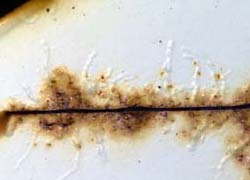Mastering Roof Inspections: Metal Roofs, Part 2
by Kenton Shepard and Nick Gromicko, CMI®
The purpose of the series “Mastering Roof Inspections” is to teach home inspectors, as well as insurance and roofing professionals, how to recognize proper and improper conditions while inspecting steep-slope, residential roofs. This series covers roof framing, roofing materials, the attic, and the conditions that affect the roofing materials and components, including wind and hail.

This roof was intentionally rusted.
Corrosion is a defect in metal roofs, and if you understand a little bit about what causes it, you’ll have a better idea of where to look for it. Three types of corrosion affect metal roofs: galvanic, crevice and filiform.
Galvanic Corrosion
Galvanic corrosion is an electrical process.
When dissimilar metals are connected by an electrolyte, such as water, the metal in the highest energy state -- the less noble metal -- will corrode. Electrons actually flow from the least noble metal to the most noble metal, and that process is galvanic corrosion.
The severity of corrosion depends on the type and amount of moisture. For example, the potential for corrosion is greater near a seashore than in a dry atmosphere. Moisture in the air in a coastal environment contains salt. Salt water conducts electricity better. So, moist, salty air is more likely to cause corrosion than moist air that’s not salty.
Galvanic corrosion does not happen in dry conditions because there’s no electrolyte to carry the current between the two metals.
Imagine a steel panel protected by a zinc coating, which is a very common roofing product. At areas where the panel is cut or where holes have been drilled, both zinc and steel can be exposed to moisture, and since zinc is the less noble of the two metals, the zinc will corrode.
Look for galvanic corrosion anywhere a panel has been cut, punctured, abraded or scratched.

Courtesy of NASA
The photo above shows a stainless steel screw in aluminum.
Crevice Corrosion
Crevice corrosion takes place when a small volume of stagnant moisture is held next to a surface long enough for the moisture to penetrate the protective coating. The crack or crevice has to be large enough for the moisture to enter, but small enough to create a stagnant zone where it just sits. Crevice corrosion usually takes place in cracks a few thousandths of an inch wide rather than in wider grooves or slots of about 1/8-inch.
Some typical areas where crevice corrosion can develop include:
- in micro-cracks in the protective coating. These tiny cracks are created during the forming process and where metal has been dented, bent or folded;
- in crevices beneath the heads of fasteners, especially over-driven fasteners, which can create indentations that can hold water;

- where fibrous fastener gaskets wick water into the space beneath the gasket where it can remain long enough to cause corrosion. In the photo above, you can see crevice corrosion in its early stages. In the photo below, you can see advanced crevice corrosion;

- between panels that are stored in a stack, such as the corrosion you see in the photo below. This corrosion took place before the panels were installed on the roof; and

- where moisture has been trapped beneath debris, such as sand, dirt and corrosive products.
Filiform Corrosion
Filiform corrosion appears as a thin filament, usually beneath paint, but sometimes beneath metal coatings.
The filament consists of an active head and a corrosion-product tail. Exactly what that corrosion product is depends on the type of metal that is corroding.
An active head means that active corrosion takes place only at the head of the filament, so corrosion doesn’t spread out uniformly; it only moves forward from the very tip of the filament.

Courtesy of NASA
Filiform corrosion doesn’t weaken metal structurally. It’s a cosmetic issue. Corrosion begins at panel edges and usually proceeds in a straight line. It appears as a network of corrosion-product tails, but an actively corroding head will not cross the tail of another filament, so that’s one way to recognize it.
**************************************************
Learn how to master a roof inspection from beginning to end by reading the entire InterNACHI series: Mastering Roof Inspections.
Take InterNACHI’s free, online Roofing Inspection Course
Mastering Roof Inspections
Roofing Underlayment Types
Inspecting Underlayment on Roofs
Fall-Arrest Systems
Roofing (consumer-targeted)
More inspection articles like this

